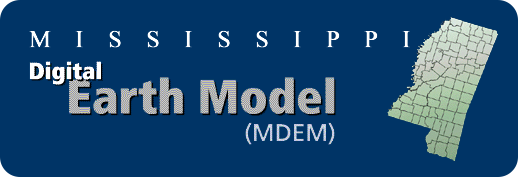Mississippi Digital Earth Model
The Mississippi Legislature, in its 2003 regular session, passed House Bill 861 to establish the Mississippi Coordinating Council for Remote Sensing and Geographic Information Systems. It also charged the Mississippi Department of Environmental Quality to manage the development of a digital land base computer model of the State of Mississippi, to be called the Mississippi Digital Earth Model (MDEM).
The law went into effect July 1, 2003, and stated in part:
“The Mississippi Department of Environmental Quality, Office of Geology and Energy Resources shall be responsible for program management, procurement, development and maintenance of the Mississippi Digital Earth Model, which should include the following seven (7) core data layers of a digital land base computer model of the State of Mississippi:
- Geodetic control;
- Elevation and bathymetry;
- Orthoimagery;
- Hydrography;
- Transportation;
- Government boundaries; and
- Cadastral. With respect to the cadastral layer, the authority and responsibility of the Mississippi Department of Environmental Quality, Office of Geology and Energy Resources shall be limited to compiling information submitted by counties.
For all seven (7) framework layers, the Mississippi Department of Environmental Quality, Office of Geology and Energy Resources shall be the integrator of data from all sources and the guarantor of data completeness and consistency and shall administer the council’s policies and standards for the procurement of remote sensing and geographic information system data by state and local governmental entities.”
What is MDEM?
The Mississippi Digital Earth Model (MDEM), in simple terms, will be an up-to-date, highly detailed, computerized map of the State of Mississippi. It will be similar to, and coordinated with, the National Map being coordinated at the federal level by the U.S. Geological Survey. The seven framework layers mentioned in the law are the standard components of electronic maps as used everywhere by the geographic information system (GIS) community. An explanation of what is meant by each of the framework layers is given below.
Geodetic control provides a common reference system for establishing the coordinate positions of all geographic data. Benchmarks are established to help provide geodetic control.
Elevation and bathymetry provide information about terrain. Elevation refers to a spatially referenced vertical position above or below a datum surface. Bathymetry refers to depths below water surfaces.
Orthoimagery refers to georeferenced images prepared from aerial photographs or other remotely sensed data from which displacements of images caused by sensor orientation and terrain relief have been removed.
Hydrography refers to water bodies, including rivers, streams, canals, ditches, reservoirs, lakes, and ponds.
Transportation features include roads and streets, railroads, bridges and tunnels, waterways and ports, and airports.
Government boundaries show the geographic areas of units of government, such as states, counties, incorporated places, minor civil divisions, and American Indian reservations.
Cadastral refers to property maps, such as those prepared by counties and used for property tax purposes. Cadastral data represent the geographic extent of the past, current, and future rights and interests in real property. These maps must show all property lines very accurately, and are usually prepared at the scale of 1 inch to 400 feet. As specified in the law, MDEQ’s role would be simply to compile the information submitted by the counties.
How will MDEQ implement MDEM?
The Mississippi Department of Environmental Quality has staff dedicated to managing the MDEM program. Click on the link for information on how to contact the MDEM staff.
It will take years to collect all of the data required to make MDEM. Some information, such as the cadastral layer, is being collected now by the counties. The challenge will be to ensure that these data are electronically compatible from county to county. Other data will be collected by MDEQ and other state government agencies. For example, the Mississippi Department of Transportation has a lot of information mapped about the transportation facilities of the state. The overall process will need to begin with the collection of high-quality, high-resolution aerial photography that will be composited and rectified into orthoimagery. Then lidar instruments will be flown to collect topographic (land surface elevation) information. The lidar data when combined with orthoimagery will allow accurate placement of streams and other water bodies, thus giving us the hydrography layer. Contractors managed by MDEQ will do the orthoimagery and lidar data collection. Funding for this phase has not yet been obtained.


